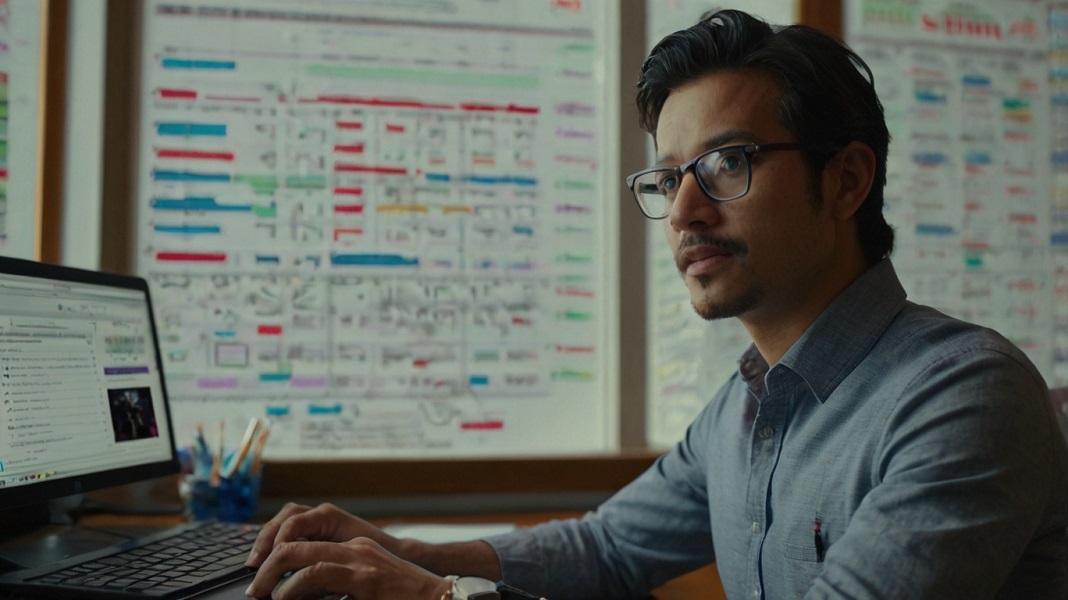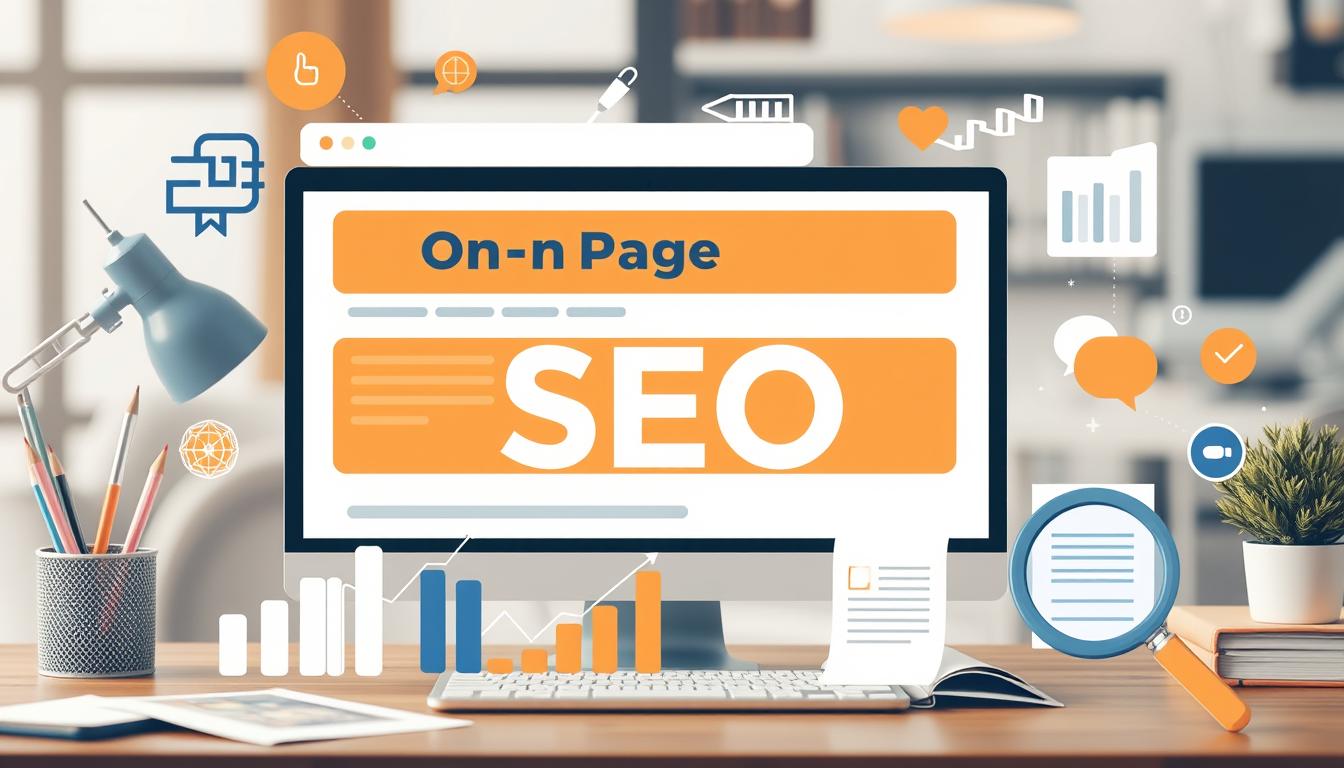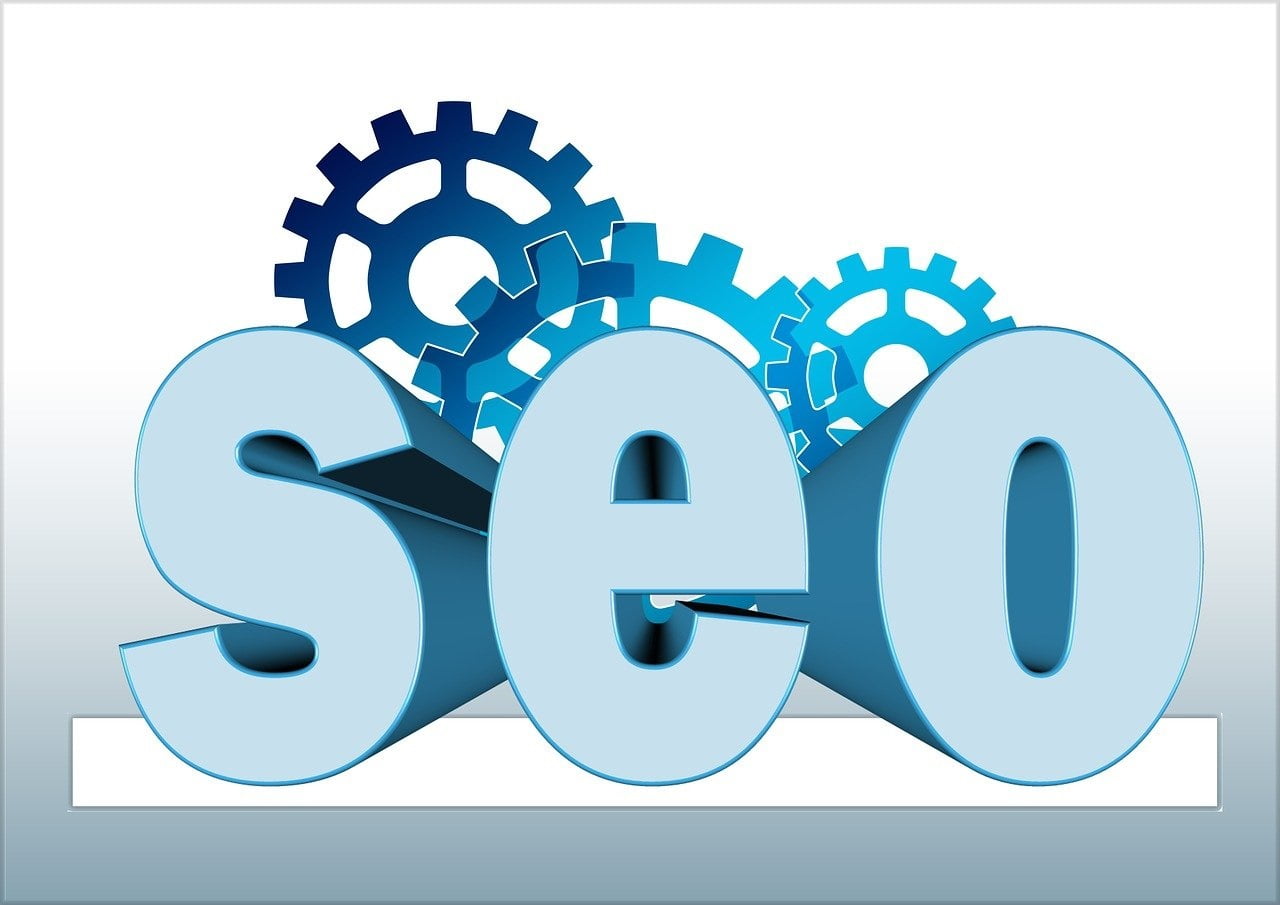Master the Rankings with Our On-Page SEO Guide
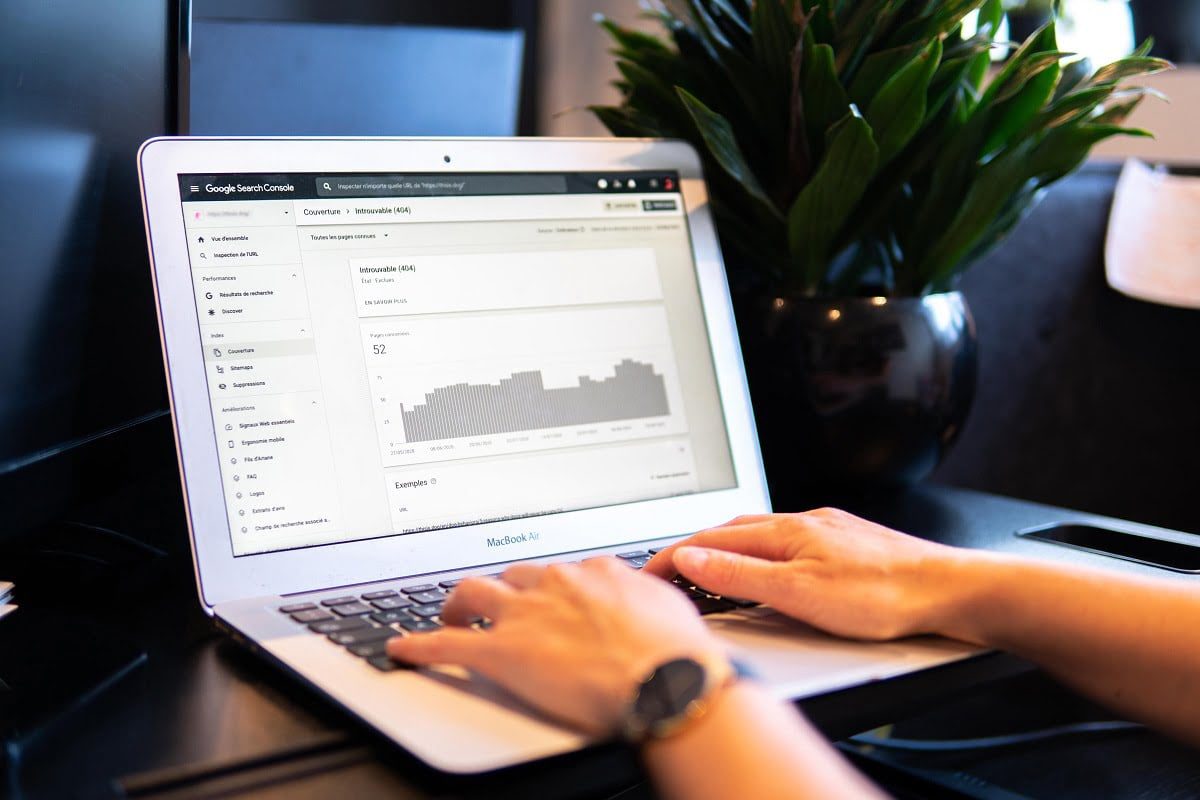
Welcome to our comprehensive On-Page SEO Guide. If you’re looking to improve your website’s rankings, you’ve come to the right place. On-Page SEO Optimization is crucial for a website’s online success, but it can be daunting to know where to start. That’s where our On-Page SEO Step By Step Guide comes in handy. We’ll walk you through the key elements of On-Page Optimization, from keyword research to HTML tag optimization. By following our guide, you’ll be well on your way to boosting your website’s visibility and search engine rankings.
Key Takeaways:
- On-Page SEO Guide is essential for boosting a website’s rankings
- Our guide will provide a step-by-step approach to On-Page Optimization
- Effective On-Page Optimization includes keyword research and HTML tag optimization
- User experience and link building are also key elements of On-Page SEO
- Tracking performance is vital to evaluate the success of On-Page Optimization efforts
Understanding On-Page SEO
To master on-page SEO, you should first understand the principles of on-page optimization. This includes the key elements to optimize on a webpage, such as content, HTML tags, and formatting. By following on-page SEO guidelines, you can improve your website’s ranking on search engines like Google.
How To Do On-Page SEO
The process of on-page optimization includes identifying target keywords, creating SEO-friendly content, optimizing HTML tags and formatting, and improving user experience. To begin, you should conduct keyword research to identify relevant keywords to incorporate into your content. This will help search engines understand the topic of your webpage and rank it accordingly.
On-Page SEO Guidelines
When creating content, it’s important to optimize headings, titles, meta descriptions, and other elements of on-page content. This involves using target keywords in a natural and organic way, without overstuffing them. Additionally, you should optimize HTML tags such as title tags, meta tags, and URL structures for better search engine visibility.
Another important aspect of on-page optimization is user experience. This includes website speed, mobile optimization, and user-friendly navigation. By improving user experience, you can increase engagement and reduce bounce rates, leading to better rankings on search engines.
By following an on-page optimization guide, you can improve the visibility of your website on search engines and attract more organic traffic to your site.
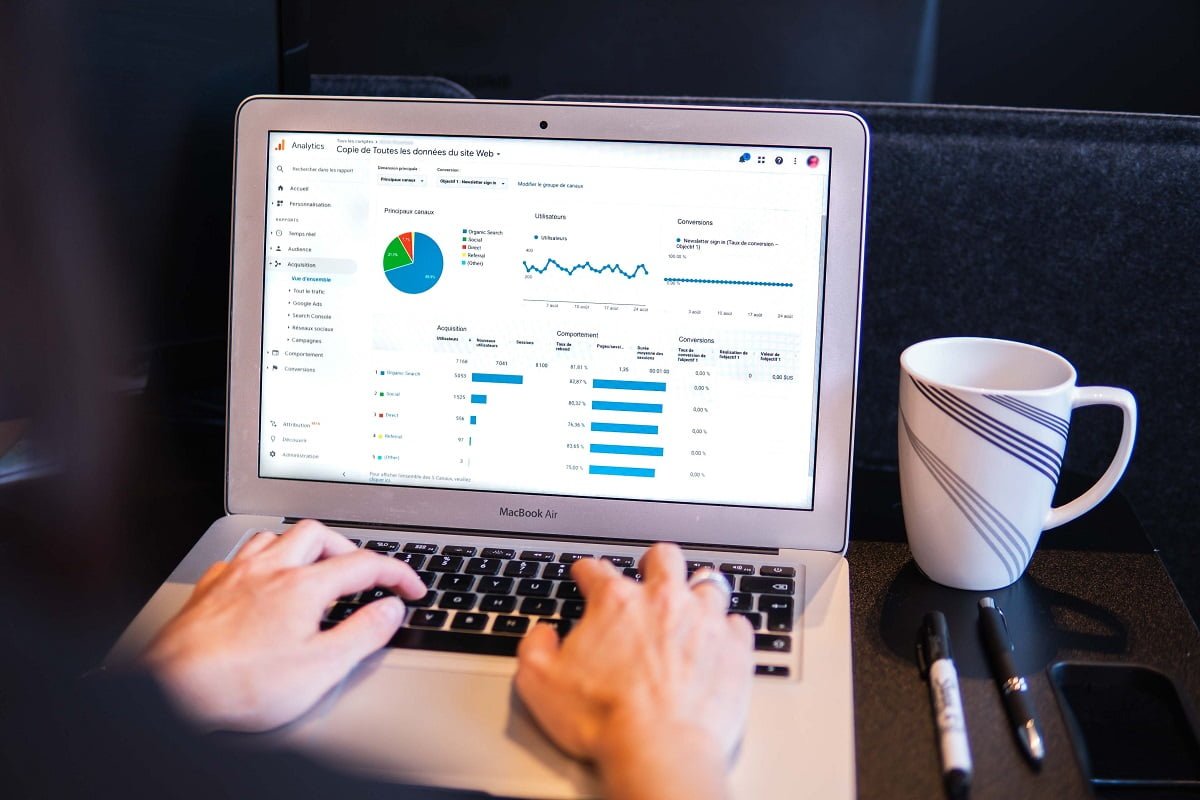
Keyword Research for On-Page Optimization
Keyword research is a crucial aspect of on-page optimization. To rank on Google’s first page, it’s essential to identify relevant keywords and incorporate them into the content. Here are some on-page SEO tips and basics to get started:
- Brainstorm potential keywords: Put yourself in the shoes of your target audience and come up with a list of potential keywords or phrases they might use when searching for your product or service. For example, if you offer web design services, keywords like “website design” or “web development” might be relevant.
- Use keyword research tools: There are numerous keyword research tools available, such as Google Keyword Planner, SEMrush, and Ahrefs. These tools can help you identify high-volume, low-competition keywords that you can use to optimize your content.
- Analyze the competition: Take a look at the content of your competitors who rank on Google’s first page. Identify the keywords they’re using and analyze their content to see how you can improve upon it.
Once you’ve identified your target keywords, it’s crucial to incorporate them into your content in a natural and effective way. Here are some on-page optimization guidelines for keyword usage:
- Use keywords in titles and headings: Incorporate your target keywords in your page titles and headings to help Google understand the main topics of your content.
- Include keywords in meta descriptions: Your meta descriptions are the short blurbs that appear in search engine results pages. Incorporating your target keywords in your meta descriptions can help improve click-through rates.
- Avoid keyword stuffing: While it’s important to use your target keywords throughout your content, avoid overusing them to the point that it feels unnatural. Remember, your content should be written for humans first and search engines second.
Creating SEO-Friendly Content
Creating high-quality, SEO-friendly content is crucial for on-page optimization. Here are some tips for optimizing different elements of on-page content:
Headings and Titles
Use H1 tags for the main title of the page and H2-H6 tags for subheadings. Incorporate relevant keywords into the headings and titles for better search engine visibility.
Meta Descriptions
Write unique meta descriptions for each page with a maximum of 155-160 characters. Use relevant keywords in the description to attract user clicks from search engine results pages.
Body Content
Include relevant keywords throughout the body content, but avoid overusing them as it can lead to keyword stuffing penalties. Use variations of keywords and natural language to make the content sound organic and well-written.
Images and Videos
Include relevant images and videos to break up the text and make the content more engaging. Optimize the file names, alt tags, and captions with relevant keywords for better search engine visibility.
Internal Linking
Link to other relevant pages within the website using anchor text that incorporates relevant keywords. This can help search engines understand the website structure and improve the ranking of the linked pages.
By following these tips, you can effectively optimize different elements of on-page content and improve your website’s visibility in the US market.
Optimizing HTML Tags and Formatting
Optimizing HTML tags and formatting is an essential component of on-page SEO strategy. By optimizing HTML tags, you can help search engines understand the content of your website better. Here are some useful tips to help you get your website on the first page of Google:
Optimizing Title Tags
Title tags are one of the most critical HTML tags for on-page optimization. They provide a brief overview of the webpage’s content and tell search engines what the content is about. To optimize title tags:
- Keep it concise and clear, preferably under 60 characters
- Include your relevant keywords to indicate the topic of the page
- Avoid repeating the same title tags on multiple pages
Optimizing Meta Descriptions
Meta descriptions are also crucial for on-page SEO. They provide a brief snippet of information about the content on your webpage. To optimize meta descriptions:
- Keep it under 155 characters to ensure it appears completely on search engine results pages (SERPs)
- Include your relevant keywords and make sure it reflects the content of the page
- Avoid duplicating meta descriptions across different pages
Formatting for Improved Readability
Formatting your content for improved readability not only makes it easier for users to read and understand but also enhances search engine visibility. To improve formatting:
- Use proper headings (H1, H2, H3…) to break up content into sections
- Make use of bullet points and numbered lists to highlight key points
- Stress important words or phrases with the tag
Optimizing URL Structures
URLs that are concise and descriptive are more likely to be clicked by users and often rank higher than lengthy or generic URLs. To optimize your URL structures:
- Include your relevant keywords in the URL
- Keep it simple and concise, avoiding unnecessary words or characters
- Avoid using dates or numbers in the URL
Table: HTML Tag Optimization Checklist
| HTML Tag | Optimization Checklist |
|---|---|
| Title Tag | Keep it concise & clear; include relevant keywords; avoid duplicate titles |
| Meta Description | Keep it descriptive; include relevant keywords; avoid duplicate meta descriptions |
| Heading Tags | Include relevant keywords; break up content into sections; use H1 for main heading |
| Em Tag | Use to emphasize keywords or phrases; don’t overuse |
| URL | Include relevant keywords; keep it concise & descriptive; avoid dates or numbers |
By optimizing HTML tags and formatting, you can improve your on-page SEO, resulting in better search engine visibility and increased traffic to your website.
Image Optimization for On-Page SEO
Optimizing images is a critical aspect of on-page SEO. When properly optimized, images can significantly contribute to the overall visibility and ranking of a website. Here are some tips on how to optimize images to rank your website on Google’s first page.
1. Optimize Image File Names
The file name of the image should be relevant to the content of the page. Avoid using generic file names such as ‘image1’ or ‘pic2’. Instead, use descriptive names that include relevant keywords. For example, if the page is about ‘best dog food’, the image file name could be ‘best-dog-food.jpg’.
2. Use Alt Tags
Alt tags help search engines understand the content of the image. It’s essential to use descriptive alt tags that include the primary keyword for the page. However, it’s crucial to avoid keyword stuffing in alt tags as this could have a negative impact on your website’s overall ranking.
3. Optimize Image Size
Large images can significantly slow down your website, leading to a poor user experience. Optimize images by compressing them without sacrificing quality. Large images can be compressed using online tools or image editing software such as Photoshop.
4. Provide Captions and Contextual Information
Adding captions and contextual information can help search engines better understand the relationship between the image and the content of the page. Captions can also improve the user experience and engagement on the page.
Following these image optimization guidelines can enhance your website’s visibility and help you rank your website on Google’s first page. Whether you are a beginner or an experienced website owner, implementing these on-page optimization techniques in WordPress or any other website builder can significantly boost your SEO efforts.
User Experience and On-Page SEO
While on-page SEO is important for improving search engine rankings, it is also crucial to consider user experience. A website that is difficult to navigate or slow to load can negatively impact user satisfaction and ultimately harm the website’s search engine visibility.
To ensure optimal user experience and on-page SEO, consider the following strategies:
- Optimize website speed: A fast loading website can improve user experience and reduce bounce rates, which can ultimately boost search engine rankings. Use tools like Google PageSpeed Insights to identify and address any speed issues.
- Ensure mobile optimization: As more users access the internet on mobile devices, it is essential to optimize websites for mobile viewing. Use responsive design and ensure that all content is accessible on mobile devices.
- Implement user-friendly navigation: Easy-to-use navigation menus and clear page layouts can improve user experience and encourage visitors to explore the website. Use descriptive labels for menus and ensure that pages are logically organized.
By prioritizing user experience alongside on-page SEO, websites can not only improve search engine rankings but also increase user satisfaction and engagement.

On-Page SEO and Link Building
Link building is a crucial component of any successful SEO strategy. It involves acquiring links from other websites that point to your own, which can help to improve your website’s authority and credibility in the eyes of search engines like Google. However, link building efforts can only be truly effective when combined with effective on-page SEO techniques.
On-page SEO and link building go hand-in-hand, as on-page optimization can help to increase the likelihood of other websites linking to your content. When your website has high-quality, optimized content that provides value to users, it becomes more likely that other websites will link to it. This, in turn, can help to boost your website’s ranking in search engine results pages (SERPs).
Internal Linking
Internal linking is one effective strategy for combining on-page SEO and link building efforts. By linking to other relevant pages on your website, you can help to establish a network of related content that search engines can crawl and index. This can help to increase the overall authority of your website, and also helps users to navigate between related content on your site.
Anchor Text Optimization
Anchor text is the clickable text that appears in a hyperlink. By optimizing your anchor text for relevant keywords, you can help to increase the relevance of your content for those keywords. This, in turn, can help to boost your website’s ranking in the SERPs for those keywords. However, it’s important to use anchor text in a natural way and to avoid keyword stuffing, which can actually hurt your website’s ranking.
Optimized Multimedia
In addition to optimizing your written content, it’s also important to optimize multimedia elements on your website, such as images and videos. By optimizing these elements with relevant keywords and descriptive file names, you can help to increase their relevance for those keywords. This can help to improve your website’s ranking in the SERPs, and also provides a better user experience for visitors to your site.
By combining on-page SEO and link building techniques, you can help to improve your website’s authority, relevance, and ranking in the SERPs. By focusing on creating high-quality, optimized content and multimedia, you can increase the likelihood of other websites linking to your content, which can further boost your website’s ranking and visibility.
Tracking On-Page SEO Performance
Tracking the performance of your on-page SEO efforts is crucial to ensure that your optimization strategies are effective in improving your website’s ranking and visibility. Several tools and methods can help you monitor your on-page SEO performance, including:
- Google Analytics: This tool provides comprehensive traffic analytics, allowing you to track your website’s traffic sources, user behavior, and other key metrics that indicate the effectiveness of your on-page SEO efforts.
- Google Search Console: This tool enables you to track your website’s search engine performance, including keyword rankings, click-through rates, and other metrics related to on-page SEO optimization.
- SEMrush: This tool offers advanced SEO analysis, including keyword research, site audits, and competitive analysis, helping you to optimize your on-page SEO efforts effectively.
- Ahrefs: This tool provides in-depth analysis of your website’s backlinks, content, and competitive ranking, offering valuable insights to improve your on-page SEO performance.
- Moz: This tool provides a range of SEO analysis and tracking features, including keyword research, site audits, and competitive analysis, helping you to boost your on-page SEO optimization efforts.
By using these tools and monitoring your on-page SEO performance regularly, you can identify areas that need improvement and adjust your optimization strategies accordingly, ensuring that your website ranks higher and becomes more visible in the US market.
Conclusion
In today’s competitive online market, mastering on-page SEO is more important than ever to improve website rankings and visibility in the US market. By implementing effective on-page optimization techniques, businesses can attract more organic traffic and increase their online presence.
Throughout this guide, we have covered the key concepts and principles of on-page SEO, including keyword research, content creation, HTML tag optimization, image optimization, user experience, and link building. We have also provided tips and strategies for tracking on-page SEO performance to evaluate the success of optimization efforts.
Key Takeaways:
- On-page SEO is crucial for improving website rankings and visibility in the US market.
- Effective optimization techniques include keyword research, content creation, HTML tag optimization, image optimization, user experience, and link building.
- Tracking on-page SEO performance is essential for evaluating the success of optimization efforts.
By following the guidelines outlined in this on-page SEO guide, businesses can improve their website’s visibility, attract more organic traffic, and ultimately achieve better success in the US market. Remember, always stay up to date with the latest trends and changes in search engine algorithms to ensure continued optimization success.
FAQ
What is on-page SEO?
On-page SEO refers to the practice of optimizing individual web pages to improve their visibility and rankings on search engine results pages (SERPs). It involves optimizing various elements on a webpage, such as content, HTML tags, and formatting, to make them more relevant and accessible to search engines.
Why is on-page SEO important?
On-page SEO is important because it helps search engines understand and interpret the content on your website. By optimizing various elements on your webpages, you can increase the chances of your website appearing prominently in search results, driving more organic traffic to your site.
What are some key elements of on-page optimization?
Some key elements of on-page optimization include keyword research and optimization, creating high-quality content, optimizing HTML tags and formatting, optimizing images, improving user experience, and incorporating internal linking strategies.
How can I conduct keyword research for on-page optimization?
To conduct keyword research for on-page optimization, you can use various tools like Google Keyword Planner, SEMrush, or Moz Keyword Explorer. Focus on finding relevant keywords with high search volume and low competition to optimize your webpages effectively.
How can I create SEO-friendly content?
To create SEO-friendly content, you should focus on incorporating relevant keywords into your headings, titles, meta descriptions, and body text. Additionally, ensure your content is informative, engaging, and well-structured to provide value to your audience and improve search engine visibility.
To optimize HTML tags and formatting for on-page SEO, you should optimize your title tags, meta tags, and URL structures with relevant keywords. Additionally, use headers (H1, H2, H3) to structure your content and include appropriate formatting such as bold and italics to highlight important information.
Why is image optimization important for on-page SEO?
Image optimization is important for on-page SEO because it helps search engines understand the content of your images. By optimizing image file names, alt tags, and captions with relevant keywords, you can enhance your website’s visibility in image search results and improve overall SEO.
How does user experience affect on-page SEO?
User experience plays a crucial role in on-page SEO. A well-designed and user-friendly website with fast loading speeds, mobile optimization, and easy navigation enhances user experience, leading to lower bounce rates and higher engagement. This, in turn, can positively impact your search engine rankings.
How can I track the performance of my on-page SEO efforts?
There are various tools and methods available to track the performance of your on-page SEO efforts. You can use tools like Google Analytics to monitor traffic sources, keyword rankings, and user behavior on your website. Additionally, you can set up goal tracking and conversion tracking to measure the success of your on-page optimization strategies.
How does on-page SEO relate to link building?
On-page SEO and link building are closely connected. By implementing effective on-page optimization techniques such as internal linking, optimizing anchor text, and creating high-quality content, you can enhance the visibility and credibility of your webpages. This, in turn, can attract more relevant and authoritative external links, further boosting your link building efforts.

